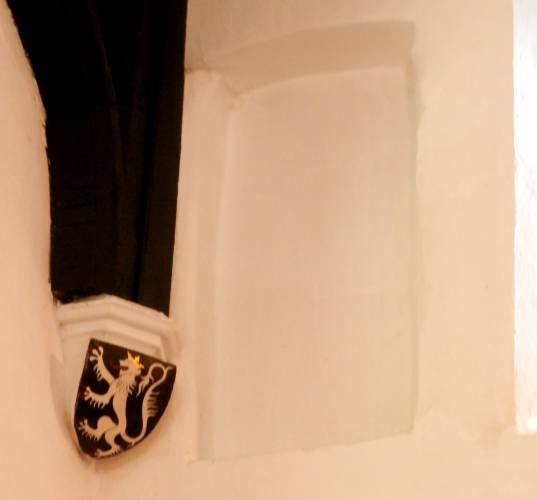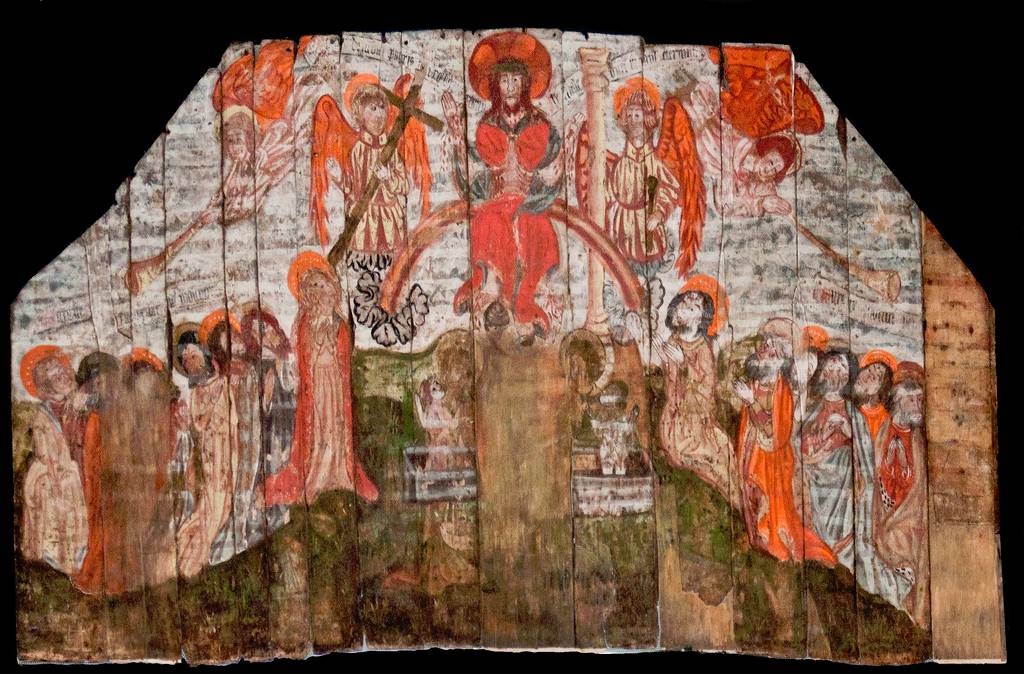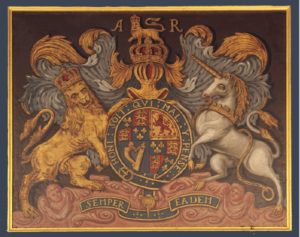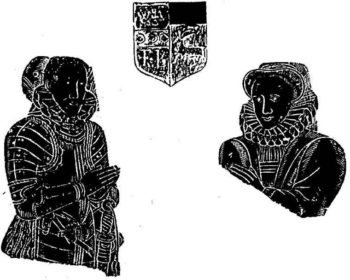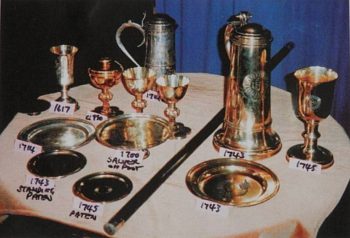Part 2: Reformation – Background Notes
Whilst researching this project, I was frequently frustrated by selective quotations from various contemporary and modern documents which illustrated the author’s point but left me without the information I needed for this essay. To try and redress that shortcoming in other sources, this section contains rather longer extracts from source documents, wills etc. which make interesting background reading to the essay section.
Contents:
Physical Evidence from the Reformation …
A Brief History of Penn Church …
The Rood …
The Penn Doom …
Sentencing and Wall Paintings …
The Royal Arms …
Glass and Windows …
A Short History of the Tudors (and some Stuarts) …
The Manors of Penn …
The Advowson and rectory of Penn …
The Penn Family in the 16C …
Penn Clergy in the 16C …
Penn Wills from the 16C …
The Edwardian Inventory from 1552 …
The Visitation of 1637 …
Monumental Brasses …
The Bells of Penn …
The Book of Common Prayer …
Merbecke …
Physical Evidence from the Reformation
A Brief History of Penn Church
Penn is a 12C church, possibly on earlier foundations, although there was almost certainly an original (wooden?) church about half a mile away down the hill on ‘Church Knoll’. The nave dates from the 12C, Tower from the 14C, and the south aisle and Lady chapel were added in mid 14C, along with nave arches. Miles Green suggests that the south aisle would have been added to support liturgical processions, the consecrated host, etc. around the church. The north and south porches originally date from the 15C (although south porch was rebuilt later). The porch was an important part of the 15C baptism liturgy, which included exorcism and other liturgy in the porch before the baby entered the church. The chancel was completely rebuilt on the base of the original walls in the 18C (after a fire?), so there is no evidence of the Reformation there. The chancel arch was also reshaped at that time, and the east arch of the south wall of the nave widened.
The Rood
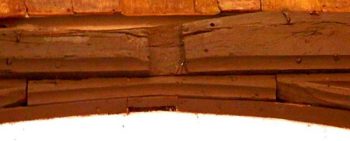 During the 1953/4 restoration and redecoration of the church, the socket for holding the Rood was found in the beam over the chancel arch. The beam has a vertical slot cut to take the vertical of the rood, and there are hooks below this, to the left and right, where the images of the Virgin Mary and St. John might have been hung. They can be seen to this day.
During the 1953/4 restoration and redecoration of the church, the socket for holding the Rood was found in the beam over the chancel arch. The beam has a vertical slot cut to take the vertical of the rood, and there are hooks below this, to the left and right, where the images of the Virgin Mary and St. John might have been hung. They can be seen to this day.
The beam over the chancel arch, showing the socket for the vertical of the Rood and the hooks beneath the beam for hanging the statues of The Virgin Mary and St. John.
On the south wall of the nave just below the beam, there is a depression in the wall, some 3ft high, 2ft wide and about a six inches deep, which might have either supported the south end of the Rood Loft, or could be the vestige of a doorway which gave access to the Rood Loft. My previous assumption had been that the rood loft must have been accessed by a ladder or external steps, as the pillar is not substantial enough to contain an internal staircase, however the restoration of 1953/4 records “the opening of the Rood Loft staircase was also found” (Records of Bucks, Vol. XVI, p50), although there is now no obvious sign of this.
The Penn Doom
Records of Buckinghamshire, Vol. XIII, 1936/7, P.362.
“The most important discovery of its kind for many years has been made in Penn Church. In the course of general redecoration and repairs some oak boards, covered in lath and plaster, and in bad condition, were taken down from a space in the east bay of the roof immediately above the chancel arch. these lay in the churchyard for a week or more before a workman accidentally found some colour on them and informed the Vicar, the Rev. K.W. Mumford. I was then called in to inspect them, and found that the sixteen boards fitted together to form a panel painting of the Doom, or Last Judgement, 12 feet wide and 6 feet 6 inches high in the centre. I was entrusted with the task of cleaning, preserving and re-assembling the painting – a work that is just completed after five weeks. as a result, one of the most impressive examples of a medieval panel painting of the Doom in this country has been preserved. It has been returned to the Church, but not placed in the roof again, where its detail would be lost. Instead it has been mounted on a specially constructed framework and fixed in the south aisle. There are only five other Dooms on boards in England, three of them tympana from the upper part of the chancel arch: so the Penn example is a great rarity. It is incomparably the richest in colour, being in a wide range of oil pigments. The iconography is somewhat unusual, since the receiving of the Saved into heaven by St. Peter, is omitted, as well as the mouth of Hell; while the general Resurrection receives meagre treatment. The main scheme is Christ in majesty flanked by angels with passion Symbols and blowing trumpets, with the Virgin and the Twelve Apostles grouped below. It is a repainting about 1480 of an earlier painting of about 1400, in which certain scenes were more profusely illustrated, the weighing of souls for example being painted out under the green foreground”.Dr. Clive Rouse.
Pat Cuthbert, a lifelong resident of Penn clearly remembers the Doom being rediscovered and being cleaned and reassembled in the Church hall. After restoration it was reassembled and hung in the south aisle until major work was undertaken on the interior and exterior of the church in 1953/4, during which time it was displayed at the Victoria and Albert museum. It was then replaced where it had been originally found, over the chancel arch. If it is reasonable to assume that this was its position at the time of the Reformation, it would have formed a tympanum over the Rood, which was set into the cross beam under the chancel arch.
“Some of the earlier painting has survived: St Michael weighing souls at the bottom and figures rising from graves. In the late illustration some angels are blowing trumpets, whilst others hold symbols of The Passion, with Christ in majesty between them, on a rainbow that is appearing between the clouds. St John the Baptist and the Blessed Virgin stand on either side of Him and below are ranged the twelve Apostles looking up with adoration. Two figures are rising from their graves, one of whom is a tonsured priest”.
Country Churches of the Chilterns, Hilary Stainer Rice, 1983.
‘Sentencing’ and Wall paintings
During the Rev. Oscar Muspratt’s restoration in 1953/4, some Sentencing was found at the east end of the south arcade of the nave, just above where the pulpit now stands. There appear to be several superimposed series of sentences, and some evidence that they were painted over some previous coloured wall painting. About two feet down and to the right of these is another area of red and yellow ochre which was found at the same time. Traces of pigment were found on other walls, “but nothing could be made of them”. Little Missenden church only four miles away has well preserved Medieval wall paintings, perhaps Penn’s may have been similar. (Abstracted from Records of Bucks. Vol. XVI, 1953/4)
The original wall paintings had to be lime-washed over at the Reformation, and the Sentences written up. Existing examples of medieval wall painting in other churches, show mainly scenes from Bible stories which were used to educate the laity. Unfortunately, many also included unlikely legends concerning local saints and a strange mixture of scripture and fiction. It was this aspect which caused the reformers to insist that they were painted over and improving texts written up in their place.
As England moved from Medieval feudalism into Elizabeth’s reign, more and more people learnt to read. The sentences would originally have included The Lord’s Prayer, verses of Scripture, and perhaps the Ten Commandments, although in the early 17C these had to be on boards over the Communion table.
“chancel wants sentencing, and the church likewise to be new sentenced and also new painted ; the boards whereon the 10 Commandments are now written to be taken down, and the 10 Com. to be set up over the Com. Table …” – Visitation of 1637
Royal Arms
“It was standard practice after the removal of the Rood and other images from the lofts to stretch canvas or some other cloth across the front of the loft and tympanum above it, on which were then painted the royal arms, the Commandments, and other biblical texts”. (Duffy, p.485)
The very large arms of Queen Anne (1702-1714) in the church dates from the early 18C, but is the successor of the royal arms of Henry VIII, Edward VI and Elizabeth, in the 16C.
Glass, Windows
There is no evidence of any stained glass from pre-Reformation, if Penn had any, it was probably removed and sold. All existing glass is 20C, apart from a small panel which may have come from the home of Baroness Sophia Charlotte Howe (1761-1835) who remarried in 1812 into the Waller family after the death of her husband in 1798. It commemorates the Waller family involvement in the Battle of Agincourt in 1415.
A Short History of the Tudors (and some Stuarts), and the Reformation
| 1485 | Henry VII, August 22nd 1485 – April 21st 1509. Became the first Tudor king, following the death of Richard III at Bosworth Field. |
|
| 1491 | Henry (VIII) born. | |
| 1503 | Henry (VIII) marries Catherine of Aragon, his brother Arthur’s widow. | |
| 1509 | Henry VIII, April 21st 1509 – January 28th 1547. | |
| 1516 | Mary born, daughter of Catherine of Aragon. | |
| 1533 | January (?), Henry VIII marries Anne Boleyn in secret. | |
| 1533 | Cranmer declares Henry’s marriage to Catherine invalid and Anne his lawful wife. | |
| 1533 | Elizabeth I born, daughter of Henry VIII and Anne Boleyn. | |
| 1534 | The Act of Supremacy, making Henry VIII ‘Supreme Head’ of the Church of England and endued with all the power hitherto exercised by the Pope (over England). | |
| 1536 | Catherine of Aragon dies of natural causes. Anne Boleyn beheaded, May 19th 1536. Henry, now free of any ‘legal’ wives, marries Jane Seymour, May 1536. |
|
| 1536 | Dissolution of the smaller monasteries. Henry VIII’s Ten Articles: Instructions to the clergy to preach against the Bishop of Rome, to discourage the veneration of images and relics and the making of pilgrimages, teach children the Lord’s Prayer, creed, and commandments in English, and to place an English Bible in each church. Not generally observed. |
|
| 1537 | The Bishop’s Book, watering down the importance of purgatory and of means of deliverance from it. | |
| 1537 | Edward VI born, at Hampton Court, Jane Seymour died soon after the birth. | |
| 1537-40 | Dissolution of the larger monasteries. | |
| 1538 | The Great Bible, in English, to be purchased and exhibited in every church, public reading in English every Sunday, of the Lord’s Prayer, creed, and commandments, and for the removal of images to which pilgrimages and offerings were customary. (The injunction was not generally obeyed). | |
| 1539 | Act of Six Articles enforcing Catholic doctrines such as transubstantiation, communion in one kind, clerical celibacy. | |
| 1539 | Henry marries Anne of Cleves. | |
| 1540 | Anne of Cleves divorced, Henry marries Catherine Howard. | |
| 1541 | Penalties imposed on churches with no English Bible, several saints day’s abolished as ‘tending to idleness’ | |
| 1542 | Catherine Howard executed. | |
| 1543 | Henry marries his sixth wife, Catherine Parr. | |
| 1543 | Henry VII’s Kings Book, reinforcing Catholic doctrines | |
| 1545 | At Henry’s decree, Cranmer’s English Litany published. | |
| 1547 | Henry dies, 28th January 1547. | |
| 1547 | Edward VI, becomes king, aged 9, January 28th 1547 – July 6th 1553 | |
| 1548 | Royal injunction, that the Latin mass was still to be used, followed by a communion service in English with both bread and wine administered to the laity. Order for removal of images from churches. (These injunctions were not universally obeyed). | |
| 1549 | Cranmer’s first English Prayer Book. Its exclusive use forced by an Act of Uniformity, January 1549. Latin mass now prohibited Prayer Book rebellion in Cornwall. |
|
| 1552 | Second English Prayer Book, of a much more Protestant tone than the 1549. | |
| 1553 | The Forty-Two articles of Religion. | |
| 1553 | Edward dies of tuberculosis, July 6th 1553, having been persuaded to ‘will’ the throne to Lady Jane Grey to ensure a Protestant succession, in defiance of Henry VIII’s will. |
|
| 1553 | Mary I, (Mary Tudor), July 20th 1553, Mary Tudor proclaimed queen. The mass and Catholic ritual reinstated within a month. |
|
| 1554 | Lady Jane Grey executed. | |
| 1556 | March 21st, Cranmer executed. | |
| 1558 | Mary dies of cancer, Nov 17th 1558. Cardinal Pole died the same day. | |
| 1558 | Elizabeth I, November 17th 1558 – March 24th 1603. Act of Supremacy making Elizabeth ‘Supreme Governor’ of the Church of England. Act of Uniformity to enforce the 1552 Prayer Book of Edward VI, with only minor modifications. |
|
| 1561 | Scotland rejects Rome and establishes Calvinism, under John Knox. | |
| 1603 | Death of Elizabeth. | |
| 1603 | James I, March 24th 1603 – March 27th 1625. | |
| 1611 | The King James Version (KJV), Authorized Version (AV) or King James Bible (KJB), was completed and authorised by Act of Parliament. In January 1604, James I convened the Hampton Court Conference, where a new English translation was conceived in response to the problems of the earlier translations. The translation was done by 47 scholars, working in six committees, and completed in 1611. | |
| 1625 | Charles I, March 27th 1625 – Jan 30th 1649, executed at Whitehall. | |
| 1649 | The Commonwealth | |
| 1653 | Oliver Cromwell declared Lord Protector, died 3rd September 1658. | |
| 1660 | The Restoration of the Monarchy. | |
| 1660 | Charles II, son of Charles I, 1660 – Feb 6th 1685. | |
| 1695 | Death of Charles II |
Mostly abstracted from The Tudor Age, James A. Williamson, Longman, 1979.
The Manors of Penn
During the 16C. there were two manors which owned parts of the parish of Penn.
A ‘subinfeudation’ took place in 1222, when the manor of Penn was divided into two portions. The part which retained the name PENN Manor, was obtained by James Penn, and although the links between the 13C Penn family and the 16C Penn family are not clear, John Penn held the manor in the early 16C, and his son David Penn died ‘seised of it’ in 1565. Penn has continued in the same family, having passed through the female line, to the Curzon’s and then to the Howe’s, who hold it today.
The other part of the parish of Penn, extending down into Knotty Green, was subinfeudated to Stephen de Segrave, and acquired the name of SEGRAVES Manor. This was purchased in 1538, by William Gardiner, although he lived at Grove Place in Chalfont St. Giles. Segraves’ property in Penn was purchased in 1607 by William Penn, and became part of the manor of Penn.
The Advowson and Rectory of Penn
The Advowson is the right of appointing a clergyman to a parish or other ecclesiastical benefice. The Rectory is the right to collect the tithes for the parish.
“The advowson of Penn Church was appertenant to Segraves manor and reserved by the Turville heirs in 1231 on the subinfeudation of the manor. Under the name of la Penne Chapel it was granted to the Prior of Chalcombe (Northants), by whom it was retained until the dissolution”. … “In 1541 the advowson and rectory were granted for life to Sibyl wife of David Penn in recognition of her services as nurse to Prince Edward (L. & P. Hen. VIII, xvi, p.718), and in 1553 the grant was confirmed to her and her heirs in fee simple (Pat. 7 Edw. VI, pt. iv ; Acts of P.C.). The Penns were lords of Penn manor with which the advowson and rectory have since descended”. (From VCH Vol. 2 p.240)
Records of Bucks. Vol. V (1878), by the Rev. J Grainger, Vicar of Penn:
“The Rectory of Penn, before the time of Henry VIII, belonged to the Priory of Chalcombe, in Northamptonshire, having been granted thereto by Lord Segrave, probably in, or shortly before 1349, when the first vicar is said to have been appointed (prior to that it was a rectory). Its value as recorded in the Kings Books (date ????), was £8 13s. 4d.”
Monasticum Anglicanum, Dugdale, Vol VI. Pt. 1.
Compat’ Ministorum Domini Regis temp Hen. VIII
[Abstract of Roll, 28 Hen. VIII. Augmentation Office]
PRIORATUS CANORICUM DE CHACOMBE
Com’ Buk’ £. s. d.
Pen – – – Reddit’ cotag’ 0 2 8
Pen – – – Firma rector 8 6 8
Chalcombe Priory appear to have sublet the rectory of Penn, along with the advowson in the early 16C. John Holland, vicar from 1527-1530, was ‘presented by Thomas Empson Esq’. William Egleston, vicar from 1520-1553, was ‘presented by John Marmon, clerk and Thomas Saunders junior, by reason of a certain donation or grant made to them by Chalcombe Priory’.
The Penn Family in the 16C.
Sybil Hampden was nurse to Edward VI after Lady Jane Grey’s death and was all her life in good standing with Elizabeth. Sybil married David Penn, and in 1540, The rectory and patronage of Penn was given to them, along with that of Little Missenden, and a considerable holding of land and property, including Parsonage Farm with its tithes and income. These were previously held by the Priory of Chalcombe in Northamptonshire until the Dissolution.
David Penn stated in his will that he wished to be buried in the church along with his ancestors, indicating that the family had been here for several generations.
The connection with William Penn of Pennsylvania is tenuous , even though he claimed descent from the Penns of Penn. After Roger Penn’s death in 1731, the patronage passed by Sarah Penn’s marriage to the Curzon family, and thence to the Howes.
Some of the Penn family remained Catholic (recusant) for another 100 years after the Reformation, whilst still retaining the right to appoint the vicar of Penn. They did have a special relationship with the Tudor’s and especially Elizabeth I, resulting from Sybil having been Edward’s nurse.
In 1584, John Penn, the patron of the living and lay rector, together with his wife Ursula and a servant, were listed as absentees from the church. His wife seems to have been more fervently recusant, since the following year she is called to account and she and a Thomas Penn agreed to pay a fixed annual fine towards providing horses for the Queen’s service in return for exemption from the penalties for recusancy. At about this time a ‘Brother Thomas Penn’ appears in the records of the Jesuits”. Ursula Penn is still listed as recusant in 1602, Alice Penn in 1610, and Martha Penn in 1635.
Penn Clergy during the 16th Century
As noted above, until the dissolution of the smaller monasteries in around 1537, Penn church, its rectory and the advowson, belonged to Chalcombe Priory in Northamptonshire. In the 16C. the rectory and advowson were sublet to other people, presumably for a financial consideration.
Chalcombe and Penn were part of the enormous Diocese of Lincoln, which stretched from the Humber to the Thames. Penn didn’t become part of Oxford diocese until the 19C. There are numerous records in the Diocese of Lincoln, (transcribed by the Lincoln Records Society), and elsewhere which provide interesting insights into the vicars and the church at Penn during the 16th Century. The Penn parish registers start in 1560, and provide a few extra items of information.
Clergy:
1500-1527 Thomas Bayley.
A Dioscesan Visitation (Bishop Atwater of Lincoln, 1519) shows:
“PEN. Disributiones non fiunt / Vicarious non residet. [expeditur]”.
Indicating that he did not live in the parish, which was very common at that time. But the Buckinghamshire Archdeaconry Court records for 1519-20 show that he paid for a curate, Richard Monkton, out of his income.
Penne
Prior et conuentus de Chacam proprietatii1 comp’ per Dauid Powell
v.d non Magister Thomas Bayley vicarius ibidem2
iiij d. Dominur Ricardus Monketon curatus ibidem
Henricus Dene firmarius
Iconomi Johannes Grove Rogerus Playter
1. Chacombe Priory, Northants; Augustinian Canons. David Powell represented Missenden Abbey as well as Chacombe at the visitation.
2. Cancelled comparet per dominum Ricardum Monketon.
The will of William Grove, 1513, shows ‘sir Wyllyam Alt my gostely fader’ (Jenkins names him as Wiiliam Salt, from the same will).
The will of Nicolas Ashwell, 1521, names ‘sir Thomas Pott’.
Both may perhaps have been curates or locums for the non-resident
Thomas Bayley.
Presented by Thomas Empson Esq. to whom Chalcombe Priory made over the right of presentation (presumably for a financial consideration).
1530-1553 William Egleston or Eccleston, Chaplain
Presented by John Marmon, clerk and Thomas Saunders junior, by reason of a certain donation or grant made to them by Chalcombe Priory.
Licensed to preach twice a year. Died 1553?
When William Eccleston took office in 1530, the clergy were Catholic and celibate. But after Henry VIII’s split with Rome, William Eccleston may have married, whilst vicar of Penn. The parish register for 15th October 1570, shows a marriage, which may be that of William Egleston’s son, between: “Jn. Egleston and Essabell Salther wid”
The first presentation by David and Sybil Penn, who were granted the patronage in 1541. He was appointed in the first year of Mary’s reign, when the catholic religion was re-imposed (I cannot find his exact dates to know if he was appointed under Edward VI or Mary).
1557-1596 John Blower. He had a curate, John Robinson B.A. (below)
He was appointed in the last year of Mary’s reign when he would have been a Catholic priest and then had to almost immediately adjust his loyalty to the reformed churchmanship and theology of the restored Book of Common Prayer in 1549.
John Blower appears in the Subscriptions of the Clergy in Bucks to the 3 Articles, [A.D. 1584], (Lambeth Palace Library, Cartae Miscellaneae tom. xiii, num. 62),
“That the Booke of common prayer and of orderinge Bishope, Prieste, and Deacons conteineth in it nothing contrairie to the worde of god, and that the same maie lawfullie be used, and that he him selfe will use the forme of the saide booke prescribed in publique prayer and administration of the sacramente and none other.
That he ailoweth the booke of Articles of Religion agreed upon by the Archbishope and Bishope of bothe provinces and the whole Clergie in the convocation holden att London in the year of our Lord god 1562 and sett forth by her Mates authoritie, and that he believeth all the articles therin contained to be agreable to the word of god”.
“Ego Johannes blawre vicarius de Penne ex animo suscribo”.
Liber Cleri 1584. (A survey of the learning or education of the clergy, 1584)
PENNE – Sir John Blower, vicar; ord. pr. by the bp. of Salisbury; 4 May 1563 ;
i. 8d. ; t. 8d. Bred in the schools.
Sir John Robinson, curate ; o. and a. he has to exhibit. B.A.
Notes:
”Sir’ – the normal form of address of the clergy at this time.
‘ Bred in the schools’ – Educated in the grammar schools and had no degree.
Penn Parish Register 1596:
John Blower Vicker of Pen was buried the xxiiith day of Aprell and died the xxiith day of the same munth
Penn Parish Register 1596:
– Robertus Rudroppe vicarius de Penne (New hand writing starts)
– M/Chris. Norton & Kath. Robertes, 29th August
– On the same day Robt Rudroppe vicar of Penn did openly in the hearing of the whole congregacon recite all the Articles wch every one admitted to any spirytuall preferment (as parsonage or vicarage) is bewnde to reade.
Liber Cleri 1603. (A survey of the learning or education of the clergy, 1603)
PEN – Q. P’ge approp. end. with a vic. V. vic. 3li. 13s. 4d. P. William Pen, Esq.
I. Robert Rudrop. D. Bat: of Arts. Pr. non L. R. est. Com. 120.
Recus. 1 woman.
Notes:
”V.’ – Should probably read 8li. 13s. 4d. or 9li. 13s. 4d.
‘Pr. non L’. – He was not licensed to preach.
‘Com. 120’ – Communicants 120 (MG estimates population about 240?)
‘Recus. 1 woman’ – One recusant, (Ursula, Alice or Martha Penn?).
Penn Wills from the 16C.
Buckinghamshire Archdeaconry Court, 1503 – 1523 (Lincoln Records Society)
Courts and Wills 1519-20, No. 332, p.242.
“In dei nomine Amen in the yere of our Lord mo vc and xiijth [1513] I Wyllyam Grove well of mynd butt sumwhatt syck of body make and orden my testament and last wyll in this manner as folowyth.
Fyrst I bequeth my soule to almyghty god to hys blessed moder saynt mary and to all the company of hevyn and my body to be buryed wtin the church yard of Penne.
Also I will that my best goode shal be my mortuary.
Item I bequeth to the moder church of Lincoln of seynt mary ij d.
Item I bequeth vnto the rode lyght of Penne j shepe.
Item to the trinite j shepe.
Item to euery lyght wtin the churche of Penn ij d.
Item to our lady chapell ij d.
Alsoo I wyll and orden John Grove my son to be my sole executor and to have all my lande and goodes after my dettes payd and my funeral expens doone.
I wyll that John Raen shalbe ouerseer of this my last wyll truly to be doone and performed.
In Wytness wherof sir Wyllyam Alt1 my gostely fader, Wyllyam Churche and Richard Deen and many oder”.
(1 or Salt, from Jenkins based on Somerset House?)
Will Book, 1521-3, No. 455, p.375.
“In the name of God Amen in the yere of our Lord God m1 vc and xxj the second day of Decembre [2 December 1521] I Nicholas Ashwell of god mynd make my testament in this wise folowing.
First I bequeth my soule to God to Our lady and to the holy cumpeny of heuyn my body to be buried in the churche yard of Penn.
Item to the mother churche of Lincoln ij d.
Item to the light of Our Lady j d.
Item to my doughter Isabell ij shepe and a bullock.
Item to John my son ij shepe and a bullocke.
Item to Cicely Aldy j shepe and a bullock.
Item to John Aldy and to Isabell Aldy a shepe.
Item I make my executours my wiffe and John Reding.
Item I will that eury of them haue for ther labour xij d.
And the ouerplus of my goodes they to dispose it for the helth of my soule.
Thies being witnes sir Thomas Pott, John Tylbery wt other”.
These early 16C wills seem to follow a fairly standard pro-forma:
1. “First I bequeth my soule to God to Our lady and to the holy cumpeny of heuyn my body to be buried in the churche yard of Penn”.
2. “Item to the mother churche of Lincoln ij d.”
3. “Item to the light of Our Lady j d.” or “Item I bequeth vnto the rode lyght of Penne j shepe”.
4. The Catholic concern for the good of the soul after death and its rapid exit from purgatory is hinted at by clauses such as:
“And the ouerplus of my goodes they to dispose it for the helth of my soule”.
Most wills are witnessed, (and perhaps written), by the local vicar. It may be that
“sir Wyllyam Alt” (or Salt), and “sir Thomas Pott” are the stand-in curates at Penn, Thomas Bayley, the vicar 1500-1527, being non-resident.
The Edwardian Inventories for Buckinghamshire 1552, (Eeles, 1908, p.iii, iv).
Following on from Henry VIII’s suppression of the monasteries and the seizure of all their goods and lands, this process was extended during Edward VI’s reign to the parish churches.
‘Enquiries as to the goods of parish churches were made of the bishops in 1547, and early in 1549 a commission for making inventories was issued to sheriffs and justices of the peace’.
‘On 3rd of March 1551 it was ordered by the Privy Council.
“that for as muche as the Kinge’s majestie had neede presently of a masse of mooney, therefore Commissions shulde be addressed into all shires of Englande to take into the kinges handes suche church plate as remaingneth, to be emploid unto his highnes use”.
This however was not done immediately. On 29th January 1552 a letter was addressed … requiring the delivery of the inventories of 1549. A commission to make new inventories and stop all private embezzlement was issued on 16 May 1552, and it was under this commission … ‘ that the following inventory for Penn was made
“This inventorye indented made [18 July 1552] of the goodes […] perteyning to the parishe of Penne […] betwene [the commissioners] and Richard Bovington and William Culverhouse all which goodes plate and jowells and other ornamentes be comytted to the safe coustodye of the sayde Richard Bovington and William Culverhouse untyll suche tyme as the kynges majesties pleasure be further knowyn.
Item ij chalices with a paten. wherof thone is stollen1.
Item iij vestymentes
Item ij copes of silke
Item iij corporas cases, and one clothe / and one crewet.
Item ij candlesticks with pikes, one crosse cloth. vj banner cloths
Item a cannapie cloth . one pillowe . iij surpleis.
Item ij towels, a pixe2 and the cannapie.
Item iiijor bells and a saunce bell3 . one bible4.
item there is solde by the consentes of Richard Bovington John Grove John Bovington John Balam Thomas Robertes Richard Wright and the churche wardens, iij great candelstikes withe other brasse to the value of xiiijs iiijd the which money is bestowed emonges the poore, and the reparations of highe wayes”.
The churche is tyled5.
[Signatures of commissioners]
(Eeles, 1908, p.43, from British Museum, MS. Lansdowne 1045, fo. 18, 1-35, no. 3)
Some comments on the above Penn inventory:
1. Presumably an earlier inventory showed two chalices (or patens?) and Richard Bovington and William Culverhouse didn’t want to be held responsible for the ‘stollen’ one.
2. ‘Pixe’ or Pyx, any receptacle used to contain the reserved host.
3. The sanctus bell. The Church Bells of Bucks., A.H. Cocks, 1897, shows it as ‘o faunce bell’, but assumes that ‘o’ is short for one.
4. Penn had a Bible, (presumably in English!). Most church inventories do not show a Bible.
5. “The churche is tyled” – Similar comments don’t appear in the inventories for other churches.
Is it possible that the commissioners considered that the tiles (floor or roof?) were an asset which could be removed and sold? Penn tiles, (i.e. Tylers Green tiles, which was part of Penn parish) were famous and were used for instance at Windsor, and Westminster Abbey.
‘A new commission was issued on 16th January 1553 directing the actual seizure of all the valuables, only the barest necessities being left for the use of each church. The result of this was that the plate was sent to the Jewel House in the Tower of London and melted down, the vestments and the inferior metalwork were sold locally, the linens given to the poor. … The lead and bells do not seem to have been actually taken’ (Eeles, p.iv).
The inventory for Penn is fairly representative and average. A few churches had very little. Hitcham (near Burnham) had “two Bibles, chalice of silver with the paten, two surplices”. Some churches, particularly High Wycombe, were exceptionally rich, and read like the inventory of a great cathedral. The pre-reformation worship at High Wycombe must have been both ornate and spectacular.
The Victoria County History of Bucks. (Vol 1. p308) points out that we cannot use the inventories to establish the practice in 1552. The inventories only list the church goods which remained in 1552, and not whether they were still in use.
“There are inventories for the Hundred of Buckingham, dated 6th May 1553, containing lists of the church goods delivered back to the parishes by the king’s commissioners. Here … each church might have a chalice and paten, a table cloth and a surplice; perhaps two of each, but nothing further. Everything else had been sold for the king’s use”. (VCH Bucks. Vol 1. p.309)
Within a year, Edward was dead, Mary Tudor on the throne, and the Catholic religion re-established. The parishes then had to replace, at their own expense, the ornaments, vestments, candlesticks, etc. which had been confiscated from them or sold only a year or so before. The rood screens had to be re-erected, stone altars rebuilt and mass books purchased.
None of the above items have survived. However “The Communion plate includes a silver-gilt cup and cover paten of 1597 (hallmark? – which would make them Elizabethan, not Jacobean ), with inscription ‘Sacrum Deo et Ecclesia de Penn C. F. 1617’, a silver paten given by Rev. John Bennett, vicar 1712, a silver flagon and alms-plate, both given by Daniel Baker in 1714”.
(VCH Bucks, Vol. 2, p239).
(All the silver was stolen from the church on the night of 19th February 2012, and never recovered)
The Visitation of 1637
In 1637, a Visitation was made of Buckinghamshire churches. Many churches were in a sorry state, although Penn comes out quite well as far as its structural maintenance is concerned. Chalfont St. Giles is reported as having: “one wall so broken, that a hog may creep through”. Whilst 1637 is outside of our 16C remit, the Visitation Report of 1637 gives us an idea of what the interior of Penn church might have looked like at the end of the 16C. It also gives us a very good insight into how well the legal requirements of the Edwardian and Elizabethan reformers had been implemented at Penn.
Records of Buckinghamshire, Vol. VI, 1887, p.257.
Extracts from the Visitation Report of 16th August 1637 (full transcript here)
Pen.–The wainscot over the Communion table to be repaired, and the chancel to be ceiled throughout ; chancel wants sentencing1, and the church likewise to be new sentenced and also new painted ; the boards whereon the 10 Commandments are now written to be taken down, and the 10 Com. to be set up over the Com. Table … the second Tome of Jewell2 wanting, the window in decay in the glass, 2 windows in the aisle in the chancel partly dammed up. Mr. Pen’s (seat) to be taken down to the mark3, it being covered, and 2 yards and a ½ high ; Mr. Norton’s and Mr. Allen’s seat built absque4, &c. ; the chancel, and Mr. Pen’s seat and Mr. Norton’s seats stand in the middle chancel ; it rains into the S. aisle, the bricked bench joining to the rails to be taken away quite ; (To provide) another flaggon suitable to that which is there ; there is a gilt chalice; a piece of wood lying out of the wall to be cut off ; Mr. Norton cometh to Pen, and doth not keep his own parish church ; the high seats in the chancel to be considered of concerning the turning of them as formerly, viz., Mr. Pen’s, Mr. Allen’s, Mr. Norton’s ; the wainscot which is over the separation of church and chancel to be made up decently as in former times ; seats of church and chancel want boarding for the most part … a high seat at the upper end of the S. aisle, viz., Mr. Carye’s built as high as Mr. Pen’s and covered likewise. Query, whether the reading-seat which is now on the S. side and is so high that it dams the light of the chancel ; will be convenient if it be joined to the pulpit, which is on the N. side ; Mr. Long and Mrs. Butterfields stand into the middle aisle, and are to be taken down to the mark; the pavements in decay …
3. Bells Sts Bell … The butterices & corners of the fteeple in decay and the fteeple and the Church and Chan. wants pgeting. (1637 Visitation report, in Cock’s, ‘Bells of Buckinghamshire’)
Notes:
- ‘Sentencing’ was the writing up of the Lord’s prayer, scriptural texts etc.. on the Church walls. Several superimposed generations of these can still be seen on the nave wall, to the south side of the pulpit.
- John Jewel (1522-1571) one of the great apologists in defence of the Church of England. The ‘second Tome of Jewel’ probably refers to the Disputation with Thomas Harding, authorised by James I, under Abp. Richard Bancroft, (in 160?). Other books required, were an up-to-date Bible in English, the Homilies, the Canons, The Paraphrases of Erasmus, etc.
- All the high box pews were to be taken down to the same level, as indicated by a ‘mark’ made by the inspectors. The high box pews, some roofed over, seem to have stood almost at random in the church, i.e. ‘Mr. Allen’s seat built absque4‘, some blocking the aisles.
- Short for ‘absque licentiam’ (i.e. without a licence). The Laudian churchmen who conducted the survey were very concerned about seats being put up in church without a faculty.
Only 37 years after end of 16C, churches in general were in a bad state, perhaps reflecting a decline in the Church’s importance in the life of the people. Does the state of the churches in the visitation reports reflect a popular (or unpopular) reaction to the Reformation?
Monumental Brasses
The brasses in Penn church date from the 16C or first half of the 17C. They were collected together in the south aisle just outside the lady chapel in 1953/4.
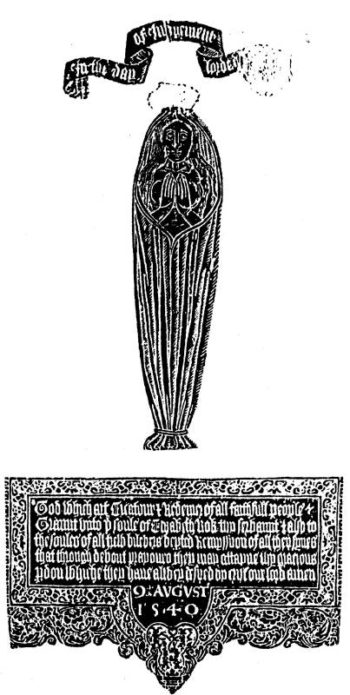 The earliest brass and perhaps the most interesting is that of Elizabeth Rok, dating from 1540. She is unusually shown in a shroud. It has an inscription in English which reads rather like a prayer in the style of the Book of Common Prayer.
The earliest brass and perhaps the most interesting is that of Elizabeth Rok, dating from 1540. She is unusually shown in a shroud. It has an inscription in English which reads rather like a prayer in the style of the Book of Common Prayer.
In the day of Judgement lorde d[eliver me]
God which art Creatour & Redemer of all faithfull people ;
Graunt unto ye soule of Elizabeth Rok thy servaunt & also to
the soules of all trew bilevers deptd remysson of all their synnes
that through devout prayours they may attayne thy gracious
pdon whiche they have alwey dsyed by Christ our lord Amen
9 August 1540
There is no other known record of Elizabeth Rok, other than her brass in the church.
Penn Family Brasses
There are brasses for the following members of the Penn family:
John Pen, esq., lord of the manor, died 2nd July 1597, aged 63, in armour, and his wife Ursula, whose date of death was never filled in. they had 6 sons.
This brass is interesting, in that it is also a palimpsest, a turned over and reused brass of c.1520, perhaps removed from a chapel or monastery which was destroyed at the Dissolution.
Wm. Pen, esq., 1638 in armour and his wife Martha, 1635. They had 1 son and 2 daughters.
The Lady Susan, wife of Sir Henry Drury Knight, and mother to Mrs. Sarah Pen wife of John Pen of this parrish esq, Shee changed this life for a better the third day of February Anno Domini 1640.
John Pen, esquire, who married Sarah the daughter of Sir Henry Drury Knight by whom he had issue five sonnes and five daughters. Hee departed this life the second of July Anno Domini 1641.
The Bells of Penn Church
From the inventory of 1552, (Eeles, 1908), we know that Penn had:
Item iiijor bells and a saunce bell.
The Church Bells of Bucks., A.H. Cocks, 1897, p.548/9, shows:
18 July, 1552, Penne, iiijor bells and o faunce bell’.
(It is a question whether this “o” means “one” or “none”; I think the former, and that the letter “n” [=”on”] is omitted).
16 Aug : 1637, Pen, 3. Bells Sts Bell … The butterices & corners of the fteeple in decay and the fteeple and the Church and Chan. wants pgeting. (1637 Visitation report)
In the register Book of Births is the following entry:—
The five bells in Penn Church were cast by Samuel Knight of Reading in Barkshire on the 29th day of December, in the year 1702 : They were hung on the 5th of January following, John Bennett being then Vicar and Thomas Winter and William Wingrove Churchwardens.
1714. 5 bells (the sanctus was probably broken up with the other bells in 1702).
The rope for the sanctus bell must have been in the tower by the west door. The man who rang the sanctus bell would have stood inside the nave where he could see the priest, performing the mass. At the appropriate point in the consecration, he would ring the Sanctus bell three times. The rope ran under the arch from the tower into the nave, and the grooves worn by the rope, in the back of the arch, during countless Masses over many centuries, can be clearly seen today.
The use of the Sanctus bell in the celebration of the Mass was discontinued at the Reformation, (perhaps when the Latin mass was replaced by the first Prayer Book in English in 1549).
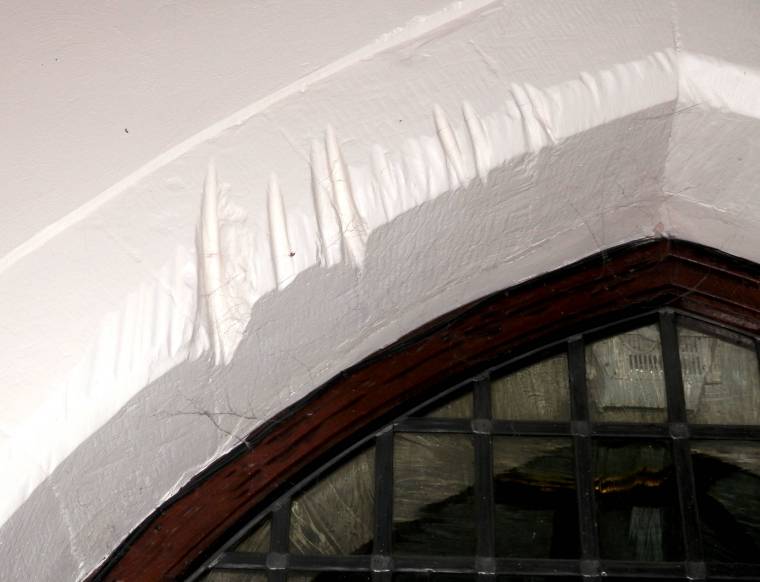 The grooves in the west arch worn by the sanctus bell rope
The grooves in the west arch worn by the sanctus bell rope
The Book of Common Prayer
Penn is to this day retains a Book of Common Prayer service at 8:00 a.m. There is a continuity of BCP worship here since the Reformation, from Cranmer’s original 1549 Prayer Book, to the present day (apart from the few years of Mary’s reign and 20 years in the 17C from the Civil War to the Restoration).
Merbecke
BCP Sung Eucharist (no longer celebrated at HT Penn) used the Merbecke setting written by John Merbecke or Marbeck in 1550 for Edward VI’s 1549 liturgy. Apart from the 20th century, we have no idea when in the last 400 years it might have been used at Penn.
“MERBECKE or MARBECK, John (d. c. 1585), English divine and musician. Appointed organist at St. George’s Chapel, Windsor, in 1541, he was condemned to the stake for heresy in 1544, because he had written the first concordance in English of the Bible. He was pardoned, however, through the influence of Bp. Stephen Gardiner, and the concordance was published in 1550 with a dedication to Edward VI. In 1550 he produced the Book of Common Prayer Noted, in which the plainchant is adapted to Edward VI’s (aka Cranmer’s) first (1549) liturgy. He continued his musical and theological studies for some years and apparently died in 1585. His son, Roger Merbecke (1536-1605), provost of Oriel College, Oxford, was chief physician to Queen Elizabeth I”. (The Oxford Dictionary of the Christian Church, 1983)
John Merbecke’s experience of being condemned to be burned for heresy under Henry VIII in 1544, and then having the same book published with a dedication to King Edward VI, only six years later, is a good example of how quickly the events of the Reformation moved, and how official policy changed, especially in Edward’s reign.

